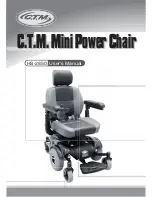
5
approaches the source. All electrical conductors act as antennas to the EM
signals and, to varying degrees, all power wheelchairs and scooters are
susceptible to electromagnetic interference(EMI). The interference could
result in abnormal, unintentional movement and/or erratic control of the
vehicle. The United States Food and drug Administration (FDA) suggests
that the following statement be incorporated
to the user’s manual for all
power wheelchairs like the P20CL
2.Be aware of nearby transmitters such as radio or TV stations and try to avoid
coming close to them.
3.If unintended movement or brake release occurs, turn the powered
wheelchair off as soon as it is safe.
4.Be aware that adding accessories or components, or modifying the powered
wheel-
chair, may make it more susceptible to interference from radio wave
sources.(Note: It is difficult to evaluate the effect on the overall immunity of
the powered wheel-
chair).
5.Report all incidents of unintended movement or brake release to the
powered wheelchair manufacturer, and note whether there is a radio wave
source nearby. Power wheelchairs and motorized scooters (in this section,
both will be referred to
as powered wheelchairs) may as susceptible to electromagnetic interference
(EMI),
which is interfering electromagnetic energy emitted from sources such as
radio stations, TV stations, amateur radio (HAN) transmitter, two-way radios
and cellular phones. The interference (from radio wave sources) can cause
the powered wheelchair to release its brakes, move by itself or move in
unintended directions. It can also permanently damage the powered
wheelchair’s control system. The inten-
sity of the EM energy can be measured in volts per meter(V/m).Each
powered wheelchair can resist EMI up to a certain intensity. This is called
“immunity level”.
The higher the immunity level, the greater the protec
t
ion. At this time,
current technology is capable of providing at least 20 V/m of immunity level,
which would provide useful protection against common sources of radiated
EMI.
Following the warnings listed below should reduce the chance of unintended
brake release or powered wheelchair movement that could result in serious






































